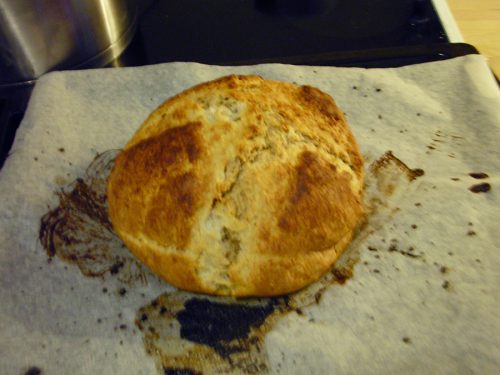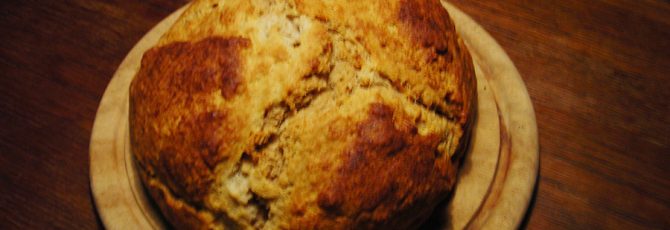In honor of St. Patrick’s Day, quickly coming up, I’m reposting an Irish soda bread blog post, and recipe, from Sept. 1, 2009 when I was living in Germany as an au pair. Here’s the original.
I realize that it’s a little bit disjointed at the end. So it goes.
You should be pairing that soda bread with some slow cooker corned beef, potatoes and cabbage made with beer, cider and mustard. Trust me. It’s really good.
Recipe: Irish Soda Bread
I could make excuses or give reasons for not having written about vacation yet, but I won’t. Instead, I’m going to share a recipe for Irish Soda Bread that I made last week. Before I give the recipe or subsequent notes on it, I’ll rap about it because I personally love recipes with a story behind them — a recipe with no notes, no story, no nothin’ is not only less appealing to me but also dry. I should say, the whole reason I made the soda bread was a beef stew which I’ll hopefully make soon again, takes pictures of and write up. A glut from two grills the last two nights engendered the beef stew, which spawned the soda bread.

Out of the oven, on a baking sheet.
I think sourdough bread goes better with beef stew, or lamb stew, or pork stew rather than soda bread, but this may just be nostalgia speaking. The soda bread goes well with the beef stew, is semi-authentic and as a plus the bread is great – it merits repeating – with a little butter and good honey.
I picked up the recipe from allrecipes.com (credit to “MP Welty”) and changed it for my tastes. My tastes at the moment are for whole wheat goodness wherever and whenever possible. So far this has been an apple crisp, the soda bread and pancakes.
Below the recipe will be given in both metric and imperial, but small measurements will be given exclusively in imperial. I personally use metric because I’m in Germany and actually I found measuring by grams to be a bit easier than the normal packing and sifting ways. However, I’ve found with American recipes, this difference can be a bit of a problem.
I made the soda bread with 50 percent normal flour and 50 percent whole wheat. Next time I’ll try all whole wheat. The original recipe calls for only normal flour.

The Irish Soda Bread on a round cutting board.
I added a little bit of extra sugar to my batch – gave the bread a slightly sweeter taste (Ferdinand [my au pair child] told me it tasted like cake, which I don’t agree with at all) that made it incredible with a spread of butter and honey.
Irish Soda Bread belongs to the chemically-leavened bread group. Instead of yeast, soda bread uses baking powder and baking soda.
The dough has a liquid baste that should be applied to the top of the bread as the baker sees fit. I found it problematic to add the baste more than once or twice because of the lost heat of the oven. However, I think the basting helped develop the crust of the bread.
The original recipe calls for a cook time of 45-50 minutes at 375° F/190° C. When the bread is formed into a big ball, the middle stays a little doughy while the crust begins to get a bit too cooked. I suggest decreasing the temperature and cooking the bread for longer. It’s done when a toothpick stuck into the middle comes out clean.
Annotated ingredients (metric):
Dough
250 grams all purpose flour (<– I used a 50/50 mix. Haven’t tried all whole wheat or all all-purpose) and 250 grams whole wheat flour OR 500 grams whole wheat flour OR 500 grams all purpose flour 50 g white sugar (I used a little more than 50 grams [probably 60-65] — gave it a sweeter flavor that went incredible with a little butter and honey as spreads)
1 teaspoon baking soda
1 tablespoon baking powder
1/2 teaspoon salt
115 g softened butter or margarine
235 ml buttermilk
1 egg
Dough-baste
55 g butter, melted
60 ml buttermilk
Ingredients imperial:
Dough
4 cups flour
4 tablespoons white sugar
1 teaspoon baking soda
1 tablespoon baking powder
1/2 teaspoon salt
1/2 cup margarine/butter, softened
1 cup buttermilk
1 egg
Dough-baste
1/4 cup butter, melted
1/4 cup buttermilk
Ingredients metric:
Dough
500 g flour
50 g white sugar
1 teaspoon baking soda
1 tablespoon baking powder
1/2 teaspoon salt
115 g margarine/butter, softened
235 ml buttermilk
1 egg
Dough-baste
55 g butter, melted
60 ml buttermilk
Instructions:
1. Preheat oven to a few degrees below 375° F/190° C
2. Mix together all the dry ingredients. Mix in the butter/margarine. Once the butter is mixed in, add the egg and buttermilk and mix well until a dough forms. Lightly flour a work surface and knead dough briefly.
3. Form kneaded dough into a ball and put on a baking sheet prepared with baking paper. Mark an X on the top of the bread ball lightly with a knife or other sharp instrument.
4. Put part of the dough-baste on the dough ball and put in the oven.
5. Baste the dough 2-3 times over the course of the 50-60 minute cooking period. 50-60 minutes at a lower temperature, 45-50 minutes at a higher (375° F/190° C.)
